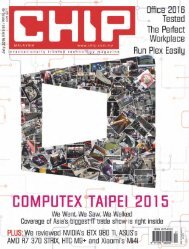You also want an ePaper? Increase the reach of your titles
YUMPU automatically turns print PDFs into web optimized ePapers that Google loves.
thelab » latest reviews<br />
LABS<br />
BENCHMARK RESULTS<br />
CINEBENCH R15<br />
INDEX - SCORE<br />
INTEL CORE I7-5775C 763<br />
INTEL CORE I7-4790K 880<br />
0 200 400 600 800 1000<br />
X264 V4.0<br />
AVERAGE FPS<br />
INTEL CORE I7-5775C 45<br />
INTEL CORE I7-4790K 53<br />
SANDRA BANDWIDTH<br />
GB/S<br />
INTEL CORE I7-5775C 20.1<br />
0 10 20 30 40 50<br />
INTEL CORE I7-4790K 17.7<br />
0 10 20 30 40 50<br />
METRO: LAST LIGHT AVERAGE FPS<br />
INTEL CORE I7-5775C 44<br />
INTEL CORE I7-4790K 52<br />
PEAK POWER<br />
WATTS<br />
INTEL CORE I7-5775C 104<br />
0 10 20 30 40 50<br />
CPU<br />
$569 | WWW.INTEL.COM.<strong>AU</strong><br />
INTEL CORE I7-4790K 195<br />
NOTE: ALL GAMES TESTED AT 1080P.<br />
0 40 80 120 160 200<br />
Intel Core i7-5775C<br />
Desktop Broadwell is here. Was it worth the wait?<br />
Intel’s fifth-gen<br />
desktop CPU, the Core<br />
i7-5775C, is finally in<br />
our test benches. So<br />
what is Broadwell? It’s a<br />
14nm production process<br />
die shrink on what’s still<br />
essentially Haswell CPU<br />
tech, giving serious power<br />
efficiency to the chips.<br />
That’s why they’re first and<br />
foremost of interest to the<br />
mobile crew, although they<br />
retain some interest on<br />
the desktop because you<br />
also get the very best in<br />
processor graphics.<br />
This is the first time the<br />
Iris Pro level of graphics has<br />
appeared in socketed form,<br />
and compared with the HD<br />
Graphics 4600 parts in the<br />
latest Haswell Devil’s<br />
Canyon chips, the Iris Pro<br />
6200 has more than twice<br />
the execution units (EUs).<br />
Elsewhere, you’re looking<br />
at classic Core i7 stats – four<br />
cores with eight threads.<br />
Because this a ‘C’ class chip,<br />
you only get a clock speed of<br />
3.3GHz with a max turbo of<br />
3.7GHz, although it retains<br />
unlocked multipliers to aid<br />
overclocking.<br />
Technologically speaking,<br />
the i7-5775C is the top CPU<br />
in Intel’s standard desktop<br />
lineup. For the next few<br />
weeks, anyway. So what<br />
makes it a relevant upgrade<br />
to the cheaper Devil’s<br />
Canyon Core i7?<br />
On the face of it, there<br />
seems to be no reason to<br />
upgrade from your current<br />
Haswell i7, and probably<br />
most existing i5 chips. The<br />
i7-5775C is a good chunk<br />
more expensive than the<br />
i7-4790K, and in terms of<br />
straight clock speed and<br />
thus gaming performance,<br />
it’s a bit of a bust. In our<br />
benchmarks, X264 and<br />
Cinebench gave a landslide<br />
victory to the last-gen CPU.<br />
The bright spot is in the<br />
memory bandwidth figures.<br />
The Broadwell chip shows<br />
big improvements, topping<br />
anything we’ve seen outside<br />
of Ivy Bridge-E processors.<br />
And what of overclocking?<br />
Sadly, we couldn’t hit the<br />
standard 1GHz overclock<br />
that Intel CPUs often offer.<br />
Boosting it from a 3.3GHz<br />
base up to 4.2GHz is no mean<br />
feat and does improve<br />
performance, but nowhere<br />
near enough to worry the<br />
existing top Haswell chip<br />
in straight performance.<br />
But this isn’t where<br />
Broadwell is meant to<br />
compete. It’s a low-power i7<br />
with high-end graphics and<br />
limited overclocking. At<br />
stock speeds, the peak<br />
power we were seeing<br />
during Cinebench tests was<br />
just 104W, with the CPU<br />
only a shade over 50°C. But<br />
even when overclocked to<br />
4.2GHz, the CPU was still<br />
under 60°C and only drew<br />
another 50W at maximum.<br />
That’s some seriously<br />
impressive efficiencies. This<br />
eight-threaded CPU is barely<br />
drawing the same power as<br />
last-gen quad-thread parts.<br />
In terms of its graphics<br />
performance, having more<br />
than twice the EUs of the<br />
Haswell HD Graphics 4600<br />
– 48 compared to 20 – the<br />
Iris Pro 6200 delivers a huge<br />
performance boost. Gaming<br />
at top 1080p settings goes<br />
from practically slideshow<br />
levels to genuinely playable.<br />
As a preview of what we<br />
can expect from the next-<br />
gen Skylake family, this<br />
14nm die shrink is darned<br />
impressive. But the thought<br />
of spending $569 on one<br />
is beyond the pale. Even<br />
with the excellent Iris Pro<br />
graphics finally hitting<br />
socketed CPUs, we struggle<br />
to see who would actually<br />
consider picking one up.<br />
This is a chip that might<br />
have looked impressive last<br />
year, and maybe even today<br />
if it had a higher clock speed<br />
and lower price. But that’s<br />
not the case, so there’s little<br />
reason to consider it.<br />
Dave James<br />
Verdict<br />
Features<br />
Performance<br />
Value<br />
Excellent power efficiency, impressive<br />
low temps and a great CPU graphics<br />
core, but it’s way too expensive.<br />
22 www.apcmag.com
















